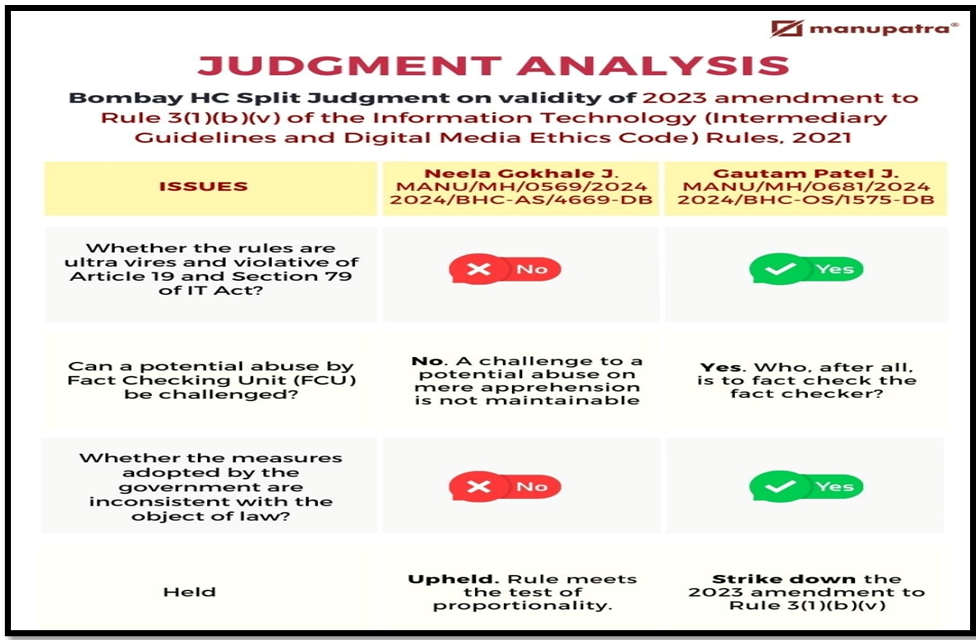JUDICIAL CLARITY ON FREE SPEECH
Syllabus:
- GS 2 : Government Policies and interventions , Fundamental rights , Judgement and Cases.
Why in the News?
- The decision by Justice Gautam Patel of the Bombay High Court on January 31st, particularly in the case known as the Kunal Kamra’s case, has brought significant clarity regarding the constitutional principles surrounding the right to free speech, especially in the realm of social media.
Constitutional Fundamentals of Free Speech:
- Justice Patel reaffirmed the sacrosanct nature of the constitutional guarantee of free speech, emphasizing that it should not be compromised except for reasonable restrictions outlined in Article 19(2) and (6) of the Constitution.
- The learned Judge reiterated that free speech is a fundamental right that should not be tinkered with or read down, except within the framework of reasonable restrictions as envisaged by the Constitution.
Source: Manupatra
Understanding The Case
Context of the Decision:
- The decision was prompted by the amended Rule 3(1)(b)(v) of the Information Technology Rules (IT Rules) 2021, which was criticized for its arbitrariness and unjust nature.
- This rule gave unfettered powers to the Fact Check Unit (FCU) to control digital content related to the business of the Central government without specifying the government’s business.
Judiciary’s Response:
- Unconstitutional Amendments:
- Justice Patel declared the amended rule unconstitutional, citing concerns over censorship, vagueness, and overbreadth, which impinged upon the right to criticize and debate.
- He argued that the amendment lacked reasonable standards and objective criteria, violating Article 19 (2), (6), and the principles of non-arbitrariness and non-discrimination in Article 14.
- Vindication of Constitutional Conscience:
- The decision upholds the democratic principle that dissent and disagreement are integral to a vibrant democracy, rejecting the chilling effect of the amended rule on the marketplace of ideas.
- Justice Patel’s elevation of the democratic principle that “the cacophony of dissent and disagreement is the symphony of a democracy at work” reflects a deep understanding of the essence of free speech in a democratic society.
- Need for Regulation Amidst Free Speech:
- While recognizing the imperative of combating misinformation, the decision underscores the need for regulation of digital platforms to safeguard individual reputation and dignity.
- It acknowledges the challenges posed by misinformation and fake news in the digital age and emphasizes the importance of addressing these issues through appropriate regulatory measures.
- Repudiation of Regulatory Overreach:
- The decision repudiates the wide-ranging and discriminatory nature of regulatory power under the amended rule, emphasizing the importance of judicial review in curbing excesses of power.
- By declaring the amended rule as ultra vires various constitutional provisions, Justice Patel reaffirms the judiciary’s role as the guardian of fundamental rights and the rule of law.
Key Challenges:
- Constitutional Clarity on Free Speech:
Clarification needed on constitutional principles regarding free speech, especially in digital contexts.
- Amended IT Rules 2021:
Concerns over arbitrary nature of amended Rule 3(1)(b)(v), granting broad powers to Fact Check Unit without clear standards.
- Constitutional Violations:
Allegations of violations against Article 19 and Article 14 due to lack of reasonable standards in the amended rule.
- Potential Abuse of Power:
Fear of regulatory abuse leading to censorship and stifling of dissent.
- Regulation of Digital Platforms:
Acknowledgment of need for regulation to combat misinformation while safeguarding individual rights.
- Judicial Oversight:
Emphasis on judicial review to ensure regulatory actions align with constitutional principles.
Way Forward:
Legislative Review:
Conduct a thorough legislative review of the amended Rule 3(1)(b)(v) of the IT Rules 2021 to ensure that it aligns with constitutional principles and guarantees of free speech.
Clarification of Standards:
Clearly define reasonable standards and objective criteria for determining the validity of decisions made by the Fact Check Unit (FCU) to prevent arbitrary censorship.
Consultation with Stakeholders:
Engage in consultations with stakeholders, including legal experts, civil society organizations, and digital platforms, to solicit feedback on regulatory measures aimed at combating misinformation.
Balancing Regulation and Free Speech:
Strike a balance between regulating digital platforms to curb misinformation while safeguarding the fundamental right to free speech and expression.
Enhanced Transparency:
Enhance transparency in the regulatory process by providing clear guidelines and procedures for content moderation and fact-checking activities.
Capacity Building:
Invest in capacity building for the Fact Check Unit (FCU) to ensure that its members possess the requisite expertise and impartiality in assessing the validity of content.
Public Awareness Campaigns:
Launch public awareness campaigns to educate citizens about the importance of critical media literacy and responsible online behavior to combat misinformation.
Judicial Oversight:
Strengthen judicial oversight mechanisms to ensure that regulatory actions are consistent with constitutional principles and do not unduly infringe upon the right to free speech.
International Best Practices:
Study and adopt international best practices in regulating digital content to strike an appropriate balance between freedom of expression and the prevention of harm.
Continuous Review and Revision:
Implement a system of continuous review and revision of regulatory measures to adapt to evolving technological and societal dynamics while upholding constitutional values.
Interagency Collaboration:
Foster interagency collaboration between government bodies responsible for content regulation, law enforcement, and human rights protection to coordinate efforts and ensure coherence in regulatory approaches.
Public Participation:
Promote public participation in the regulatory process by soliciting feedback through public consultations and open forums to ensure accountability and legitimacy.
Conclusion:
- Justice Patel’s decision represents a convergence of constitutional principles and societal sensitivities regarding free speech, emphasizing the importance of upholding fundamental rights in a democratic society.
- It is hoped that the government will defer to judicial decisions and refrain from operationalizing the amended rule until its constitutional validity is conclusively determined.
Source:
https://www.thehindu.com/opinion/op-ed/judicial-clarity-on-free-speech/article67866821.ece
Mains Practice Question:
Evaluate the challenges in balancing regulation of digital platforms with the protection of free speech, considering the evolving dynamics of technology and societal norms.




